Diagnosis of peri-implantitis in the absence of baseline data: A diagnostic accuracy study
Abstract
Objectives
The aim of the present study was to evaluate the diagnostic accuracy of clinical and radiographic evaluations made at a single time point during follow-up in identifying (a) a history of peri-implant bone loss and (b) the presence of peri-implantitis.
Material & Methods
427 patients provided with implant-supported reconstructions 9 years earlier were evaluated clinically by Probing Pocket Depth, Bleeding or Suppuration on Probing (PPD, BoP & SoP) and radiographically. Bone levels were assessed relative to the most coronal point of the intra-osseous part of the implant. A history of bone loss and diagnosis of peri-implantitis was confirmed through baseline documentation (direct evidence). Diagnostic accuracy of radiographic bone levels at 9 years and clinical findings (indirect evidence/secondary case definition) in identifying a history of bone loss and peri-implantitis were evaluated through correlation and multilevel regression analyses as well as receiver operating characteristic curves. Results were expressed as sensitivity/specificity and area under the curve (AUC).
Results
Bone levels observed at 9 years were highly accurate in identifying pronounced bone loss (>2 mm; AUC = 0.96; 95% CI 0.95–0.98). In the absence of baseline documentation, a secondary case definition based on the presence of BoP/SoP & bone level ≥ 1 mm (indirect evidence) provided the overall best diagnostic accuracy (AUC = 0.80; 95% CI 0.77–0.82) in identifying peri-implantitis cases (direct evidence: BoP/SoP & bone loss > 0.5 mm). Moderate/severe peri-implantitis (BoP/SoP & bone loss > 2 mm) was most accurately identified by the combination of BoP/SoP & bone level ≥ 2 mm (AUC = 0.93; 95% CI 0.91–0.96). Sensitivity of the secondary case definition suggested by the 2017 World Workshop of Periodontology (WWP) (BoP/SoP ≥ 1 site & bone level ≥ 3 mm & PPD ≥ 6 mm) was low.
Conclusions
The present results underline the importance of baseline documentation for the correct diagnosis of peri-implantitis, especially in its early/incipient forms. The secondary case definition of peri-implantitis suggested at the 2017 WWP demonstrated a high level of specificity but low sensitivity. Moderate/severe peri-implantitis was most accurately identified by the combination of BoP/SoP & bone level ≥ 2 mm.
CONFLICTS OF INTEREST
Dr. Jan Derks reports personal fees from Dentsply Sirona and Straumann AG, outside the submitted work. Dr. Mariano Sanz reports grants and personal fees from Dentsply Sirona, Straumann AG, Nobel Biocare, Camlog Implants, Mozo-Grau Implants, Dentium Implants, Sweden and Martina Implants and Klockner Implants outside the submitted work. Dr. Tord Berglundh reports grants and personal fees from Dentsply Sirona, outside the submitted work. The authors declare no potential conflicts of interest with respect to the authorship and/or publication of this article.




